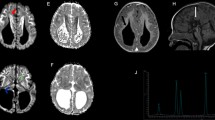Abstract
Monocarboxylate transporter 1 (MCT1) deficiency was first described in 2014 by Hasselt et al. as a novel genetic cause of recurrent ketoacidosis. Patients present in the first year of life with acute episodes of ketoacidosis triggered by fasting or infections. Patients with homozygous mutations are known to have a more severe phenotype with mild to moderate developmental delay and an increased prevalence of epilepsy. There is only one recent report of the neuroimaging findings of this disorder as reported by Al-Khawaga et al. (Front Pediatr. 7:299, 2019). We report the neuroimaging abnormalities in two siblings with similar clinical presentation of recurrent ketoacidosis, seizures, and developmental delay. Whole exome sequencing in the younger sibling confirmed a known pathogenic homozygous mutation in MCT1, also known as SLC16A1 gene. Brain MRI showed a similar very distinctive pattern of signal abnormality at the gray-white matter junction, basal ganglia, and thalami in both patients. Both siblings had agenesis of the corpus callosum. Knowledge of this pattern of brain involvement might contribute to an earlier diagnosis and timely management of this rare and under recognized disorder.


Similar content being viewed by others
References
Halestrap AP (2013) The SLC16 gene family—structure, role and regulation in health and disease. Mol Asp Med 34:337–349
Van Hasselt PM, Ferdinandusse S, Monroe GR et al (2014) Monocarboxylate transporter 1 deficiency and ketone utilization. N Engl J Med 371:1900–1907
Al-Khawaga S, AlRayahi J, Khan F, Saraswathi S, Hasnah R, Haris B, Mohammed I, Abdelalim EM, Hussain K (2019) A SLC16A1 mutation in an infant with ketoacidosis and neuroimaging assessment: expanding the clinical spectrum of MCT1 deficiency. Front Pediatr 7:299
Bergersen LH (2007) Is lactate food for neurons? Comparison of monocarboxylate transporter subtypes in brain and muscle. Neuroscience 145:11–19
Merezhinskaya N, Fishbein WN, Davis JI, Foellmer JW (2000) Mutations in MCT1 cDNA in patients with symptomatic deficiency in lactate transport. Muscle Nerve 23:90–97
Otonkoski T, Jiao H, Kaminen-Ahola N, Tapia-Paez I, Ullah MS, Parton LE, Schuit F, Quintens R, Sipilä I, Mayatepek E, Meissner T, Halestrap AP, Rutter GA, Kere J (2007) Physical exercise-induced hypoglycemia caused by failed silencing of monocarboxylate transporter 1 in pancreatic beta cells. Am J Hum Genet 81:467–474
Balasubramaniam S, Lewis B, Greed L et al (2016) Heterozygous monocarboxylate transporter 1 (MCT1, SLC16A1) deficiency as a cause of recurrent ketoacidosis. JMD Rep 29:33–38
Bergersen LH, Eid T (2014) Monocarboxylate transport matters. N Engl J Med 371(20):1931–1932
Lauritzen F, Eid T, Bergersen LH (2015) Monocarboxylate transporters in temporal lobe epilepsy: roles of lactate and ketogenic diet. Brain Struct Funct 220(1):1–12
Patay Z (2005) Diffusion-weighted MR imaging in leukodystrophies. Eur Radiol 15(11):2284–2303
Okumura A, Kidokoro H, Tsuji T, Suzuki M, Kubota T, Kato T, Komatsu M, Shono T, Hayakawa F, Shimizu T, Morishima T (2009) Differences of clinical manifestations according to the patterns of brain lesions in acute encephalopathy with reduced diffusion in the bilateral hemispheres. AJNR Am J Neuroradiol 30(4):825–830
Williams JA, Bede P, Doherty CP (2017) An exploration of the spectrum of peri-ictal MRI change; a comprehensive literature review. Seizure 50:19–32
Bireley WR, Van Hove JL, Gallagher RC, Fenton LZ (2012) Urea cycle disorders: brain MRI and neurological outcome. Pediatr Radiol 42(4):455–462
Sass JO (2012) Inborn errors of ketogenesis and ketone body utilization. J Inherit Metab Dis 35:23–28
Funding
No funding was received for this study.
Author information
Authors and Affiliations
Corresponding author
Ethics declarations
Conflict of interest
The authors declare that they have no conflict of interest.
Ethical approval
All procedures performed in the studies involving human participants were in accordance with the ethical standards of the institutional research committee and with the 1964 Helsinki Declaration and its later amendments or comparable ethical standards.
Informed consent
Informed consent was not obtained as there is no information included in the submitted material that allows identification of patients.
Additional information
Publisher’s note
Springer Nature remains neutral with regard to jurisdictional claims in published maps and institutional affiliations.
Rights and permissions
About this article
Cite this article
Nicolas-Jilwan, M., Medlej, R., Sulaiman, R.A. et al. The neuroimaging findings of monocarboxylate transporter 1 deficiency. Neuroradiology 62, 891–894 (2020). https://doi.org/10.1007/s00234-020-02435-7
Received:
Accepted:
Published:
Issue Date:
DOI: https://doi.org/10.1007/s00234-020-02435-7




